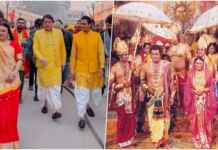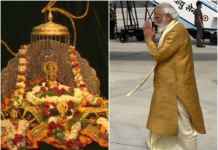Check out some key features of Ram Janmabhoomi Mandir:
Ayodhya, located in Uttar Pradesh, is ready for the highly anticipated grand pran-pratishtha (consecration ceremony) of the newly constructed Ram Janmabhoomi Temple on Monday afternoon. This sacred event, signifying the consecration of the deity in the temple’s inner sanctum, holds significant historical and cultural importance, marking a profound and symbolic moment.
Prime Minister Narendra Modi is set to preside over the consecration ceremony, which will be conducted by a team of priests led by Varanasi’s Lakshmikant Dixit. The event will witness the participation of representatives from major spiritual and religious sects across the country, along with dignitaries from various walks of life, including delegates from tribal communities. Notably, this mega event has garnered attention not only on the national stage but also on the global platform.

The architectural brilliance behind the temple is attributed to the renowned Chandrakant B Sompura, who collaborated with his son Ashish for the design. The Ram Mandir, as described by the Shri Ram Janmbhoomi Teerth Kshetra Trust, follows the traditional Nagara style of construction.
Features:
-
- The Ram Janmabhoomi Mandir, built in the classic Nagara architectural style, spans 380 feet in length (east-west), 250 feet in width, and rises to a height of 161 feet.
- The Mandir is supported by a collective count of 392 pillars and features 44 doors. It is structured across three stories, each towering at a height of 20 feet. The pillars and walls are adorned with intricately sculpted representations of Hindu deities, gods, and goddesses.
- Within the main sanctum sanctorum, the focal point will be the idol of Bhagwan Shri Ram in his childhood form, known as Shri Ram Lalla. Additionally, on the first floor, a depiction of Shri Ram Darbar will be prominently featured.
- The temple encompasses a total of five halls, known as mandaps, which include Nritya Mandap, Rang Mandap, Sabha Mandap, Prathana Mandap, and Kirtan Mandap.
- Accessible by ascending 32 stairs through the Singh Dwar, the primary entrance to the temple is located on the eastern side.
- The temple compound features four Mandirs at its corners, dedicated respectively to Surya Dev, Devi Bhagwati, Ganesh Bhagwan, and Bhagwan Shiv. Additionally, there is a Mandir of Maa Annapurna in the northern arm and a Mandir of Hanuman ji in the southern arm.
Features of Shri Ram Janmbhoomi Mandir
1. The Mandir is in the traditional Nagar style.
2. The Mandir has a length (east-west) of 380 feet, a width of 250 feet, and a height of 161 feet.
3. The Mandir is three-storied, with each floor being 20 feet tall. It has a total of 392… pic.twitter.com/Sp2BzzU5sv
— Shri Ram Janmbhoomi Teerth Kshetra (@ShriRamTeerth) January 4, 2024
- The temple’s foundation is reinforced by a significant number of columns. The ground floor is supported by 160 columns, the first floor by 132 columns, and the second floor, distinguished by intricate design and detailing, is upheld by 74 columns, ensuring both stability and aesthetic appeal.
- The temple has provisions of ramps and lifts for the convenience of the differently-abled and elderly.
- The construction of the Ram Mandir in Ayodhya takes a unique approach by avoiding the use of steel or iron. Instead, the project uses traditional construction materials, aligning with age-old building practices and demonstrating a commitment to sustainability.
- The primary construction material for the main temple structure is Bansi Paharpur Pink Sandstone, sourced from the Bharatpur district in Rajasthan. Granite stones are employed in the plinths, ensuring a robust and enduring foundation for the temple. The inclusion of granite not only enhances structural strength but also extends the overall longevity of the temple. Additionally, intricate inlay work is crafted using White Makrana marble and colored marble, adding a decorative touch to the structure.
- The Shri Ram Janmabhoomi Teerth Kshetra estimated that ₹1,800 crore would be expended in bringing the architectural marvel to fruition. Between February 5, 2020, and March 31, 2023, an expenditure of ₹900 crore was reported in the pursuit of constructing the Ram Temple.
Jai Shree Ram






























